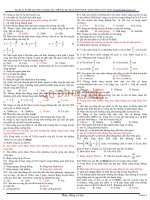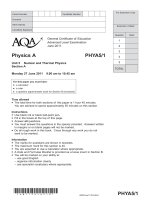- Trang chủ >>
- Khoa Học Tự Nhiên >>
- Vật lý
Vật lý A level: AQA PHYA5 2d w QP JUN11
Bạn đang xem bản rút gọn của tài liệu. Xem và tải ngay bản đầy đủ của tài liệu tại đây (474.98 KB, 12 trang )
(JUN11PHYA52D01)
WMP/Jun11/PHYA5/2D
PHYA5/2D
Centre Number
Surname
Other Names
Candidate Signature
Candidate Number
General Certificate of Education
Advanced Level Examination
June 2011
Time allowed
l
The total time for both sections of this paper is 1 hour 45 minutes.
You are advised to spend approximately 50 minutes on this section.
Instructions
l
Use black ink or black ball-point pen.
l
Fill in the boxes at the top of this page.
l
Answer all questions.
l
You must answer the questions in the spaces provided. Do not write
outside the box around each page or on blank pages.
l
Do all rough work in this book. Cross through any work you do not
want to be marked.
Information
l
The marks for questions are shown in brackets.
l
The maximum mark for this section is 35.
l
You are expected to use a calculator where appropriate.
l
A Data and Formulae Booklet is provided as a loose insert.
l
You will be marked on your ability to:
– use good English
– organise information clearly
– use specialist vocabulary where appropriate.
For this paper you must have:
l
a calculator
l
a ruler
l
a Data and Formulae Booklet.
Physics A PHYA5/2D
Unit 5D Turning Points in Physics
Section B
Monday 27 June 2011 9.00 am to 10.45 am
MarkQuestion
For Examinerʼs Use
Examinerʼs Initials
TOTAL
1
2
3
4
WMP/Jun11/PHYA5/2D
Do not write
outside the
box
Section B
The maximum mark for this section is 35 marks. You are advised to spend approximately
50 minutes on this section.
1 In Figure 1, a beam of monoenergetic electrons is produced by thermionic emission
from a wire filament in an evacuated tube. The beam is directed at a thin metal sample
at normal incidence and it emerges from the sample in certain directions only, including
its initial direction.
Figure 1
1 (a) (i) Name the physical process occurring at the thin metal sample in Figure 1 which shows
the electrons behaving as waves.
(1 mark)
1 (a) (ii) Explain why the electrons need to be monoenergetic in order for them to emerge in
certain directions only.
(2 marks)
(02)
2
beam of
electrons
anode
thin metal
sample
filament
cathode
WMP/Jun11/PHYA5/2D
Tur n over
ᮣ
(03)
Do not write
outside the
box
1 (b) A transmission electron microscope (TEM) operating at an anode potential of 25 kV is
used to observe an image of a thin sample.
1 (b) (i) Calculate the momentum of the electrons emerging from the anode, stating an
appropriate unit.
answer =
(4 marks)
1 (b) (ii) Describe and explain how the resolution of the image would change if the anode
potential were increased.
(3 marks)
3
10
WMP/Jun11/PHYA5/2D
Do not write
outside the
box
2 In an experiment to measure the charge of the electron, a charged oil droplet of
unknown mass was observed between two horizontal parallel metal plates, as shown in
Figure 2.
Figure 2
2 (a) The droplet was observed falling vertically at its terminal speed when the pd between
the plates was zero.
2 (a) (i) By considering the forces acting on the droplet as it falls at its terminal velocity, v,
show that the radius, r, of the droplet is given by
r =
where
η
is the viscosity of air and
ρ
is the density of the oil droplet.
(2 marks)
2 (a) (ii) Explain how the mass of the oil droplet can be determined from its radius, r.
(1 mark)
4
(04)
•
charged
oil droplet
+
–
9ηv
2ρ g
1
2
( )
WMP/Jun11/PHYA5/2D
Tur n over
ᮣ
(05)
8
Do not write
outside the
box
5
2 (b) (i) The two horizontal parallel metal plates were 5. 0 mm apart. The mass of the
droplet was 6. 8 × 10
–15
kg.
The droplet was held stationary when the plate pd was 690 V.
Calculate the charge of the oil droplet, expressing your answer to an appropriate
number of significant figures.
answer C
(3 marks)
2 (b) (ii) Millikan made the first accurate measurements of the charge carried by charged oil
droplets. Outline what Millikan concluded from these measurements.
(2 marks)
Turn over for the next question
WMP/Jun11/PHYA5/2D
Do not write
outside the
box
3 (a) Newton suggested a theory that light is composed of corpuscles. He used his theory to
explain the refraction of a light ray travelling from air to glass, as shown in Figure 3.
Huygens explained the refraction of light using his own theory that light consists of
waves.
Figure 3
3 (a) (i) State one reason why Huygens’ theory of light was rejected for many years after it
was first proposed, in favour of Newton’s corpuscular theory of light.
(1 mark)
3 (a) (ii) Explain why the eventual measurement of the speed of light in water led to the
definite conclusion that light consists of waves and not corpuscles.
(2 marks)
6
(06)
air glass
normal
path of
light
waves
WMP/Jun11/PHYA5/2D
(07)
Do not write
outside the
box
3 (b) Young demonstrated that a pattern of alternate bright and dark fringes was observed
when light from a narrow single slit passed through double slits, as shown in Figure 4.
Figure 4
Newton’s corpuscular theory predicted incorrectly that just two bright fringes would be
formed in this pattern. Use Huygens’ theory of light to explain why more than two
bright fringes are formed in this pattern.
The quality of your written communication will be assessed in this question.
(6 marks)
7
Tur n over
ᮣ
9
single slit
light
source
double slits
microscope
observe
r
WMP/Jun11/PHYA5/2D
Do not write
outside the
box
4 In an experiment, a beam of protons moving along a straight line at a constant speed of
1.8 × 10
8
ms
–1
took 95 ns to travel between two detectors at a fixed distance d
0
apart. As
shown in Figure 5.
Figure 5
4 (a) (i) Calculate the distance d
0
between the two detectors in the frame of reference of the
detectors.
answer = m
(1 mark)
4 (a) (ii) Calculate the distance between the two detectors in the frame of reference of the
protons.
answer = m
(2 marks)
8
(08)
beam of protons
detector detector
d
0
WMP/Jun11/PHYA5/2D
Do not write
outside the
box
4 (b) A proton is moving at a speed of 1. 8 × 10
8
ms
–1
Calculate the ratio
kinetic energy of the proton
rest energy of the proton
answer =
(5 marks)
END OF QUESTIONS
9
(09)
8
WMP/Jun11/PHYA5/2D
Do not write
outside the
box
10
(10)
There are no questions printed on this page
DO NOT WRITE ON THIS PAGE
ANSWER IN THE SPACES PROVIDED
WMP/Jun11/PHYA5/2D
(11)
Do not write
outside the
box
11
There are no questions printed on this page
DO NOT WRITE ON THIS PAGE
ANSWER IN THE SPACES PROVIDED
WMP/Jun11/PHYA5/2D
(12)
Do not write
outside the
box
12
There are no questions printed on this page
DO NOT WRITE ON THIS PAGE
ANSWER IN THE SPACES PROVIDED
Copyright © 2011 AQA and its licensors. All rights reserved.









